Kalakand is a popular Indian sweet made with milk, sugar and a few flavorings. My three ingredient, super fast recipe for Kalakand (a.k.a. Indian Milk Cake) comes together in just 15 minutes thanks to the help of a can of sweetened condensed milk. This fudgy sweet is easy to customize and is naturally gluten free, making it the perfect dessert to celebrate with.
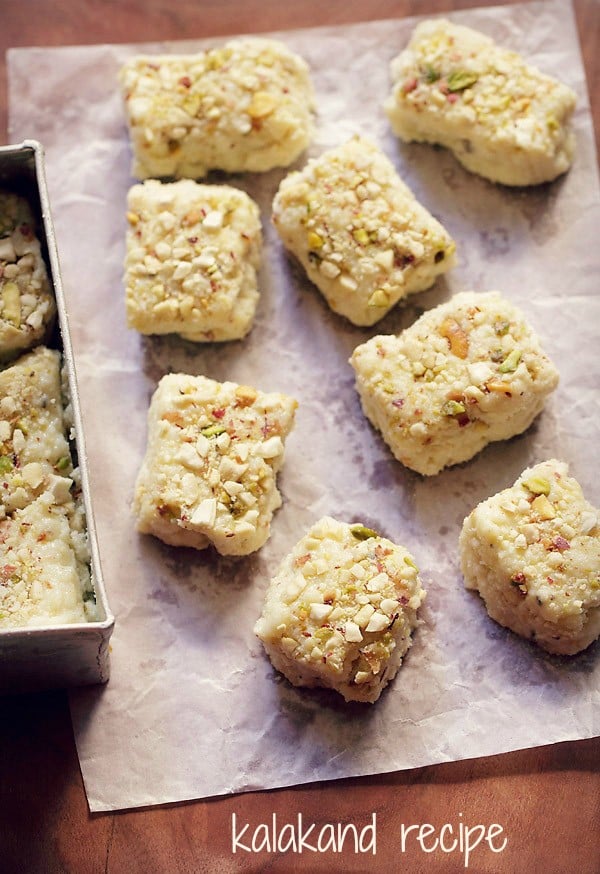
Table of Contents
About This Kalakand Recipe
Kalakand is one of the most popular Indian sweets, and with good reason. This milk cake is creamy, dreamy and completely addictive.
I could eat a whole batch just to myself! If you are looking for easy Diwali Sweets Recipes , this is the recipe you need.
To make kalakand traditionally, the milk is lightly curdled with a bit of alum or Curd or citric acid and simmered until thickened.
While the traditional method of making this dessert is rather long, I have found a great short cut: sweetened condensed milk!
The taste and texture of this milk cake is perfectly sweet, creamy, moist and granular – you’d never know that it was made with a can of sweetened condensed milk!
The recipe yields about ½ kg kalakand, making a perfect amount for a small family. Feel free to scale the recipe to your needs.
If you’re unfamiliar with kalakand, this is a dessert that should absolutely be on your radar. Not only does this recipe make it super easy to throw together, but it is also completely customizable.
I usually add cardamom powder and rose water, but saffron, vanilla, dried fruits and nuts can all be added to make your own perfect treat.
So just to review: this dessert recipe takes just two base ingredients and 15 minutes to make, is easy to customize and is gluten free to boot. What’s not to love?? So let’s get to the kitchen and start making this delectable kalakand milk cake.
How to Make Kalakand Recipe
Make Kalakand Mixture
1. Grate or finely crumble 250 to 300 grams paneer to yield about 2 tightly packed cups.
If the paneer is refrigerated, I suggest you grate it. If using freshly made paneer or chenna, then you can crumble it. Please note there should be no chunks in the crumble.
Tip: For the best results, I always suggest you use Homemade Paneer.
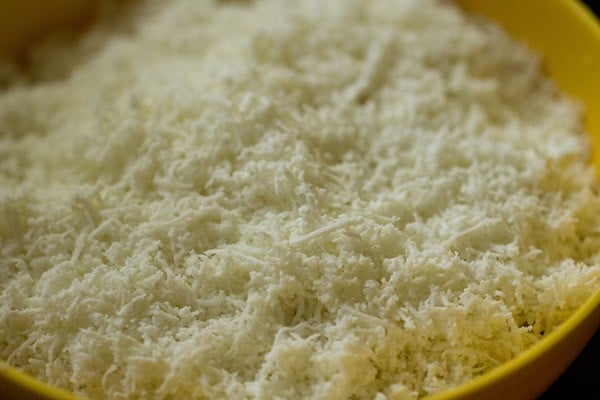
2. Add 1 tin/can (400 grams) of sweetened condensed milk to a thick bottomed pan or kadai.
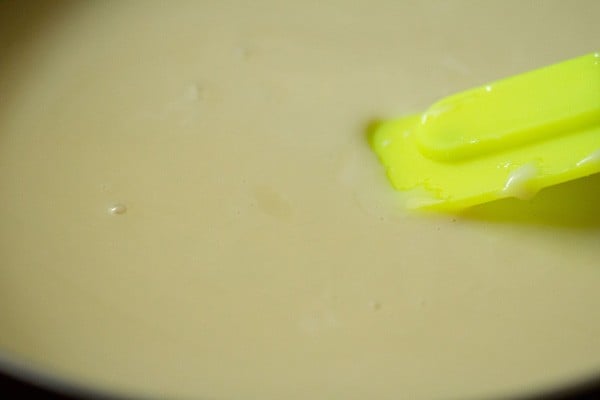
3. Add the grated or crumbled paneer to the condensed milk.
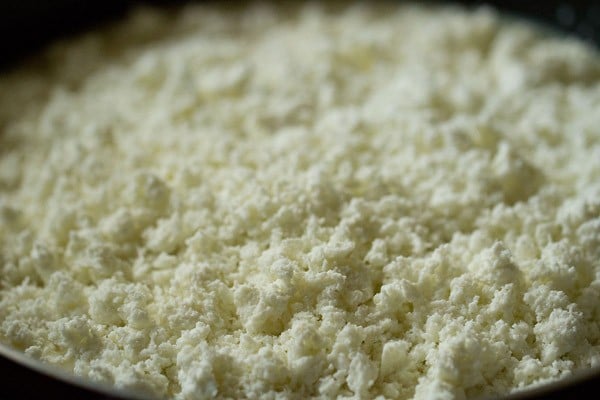
4. Mix very well.
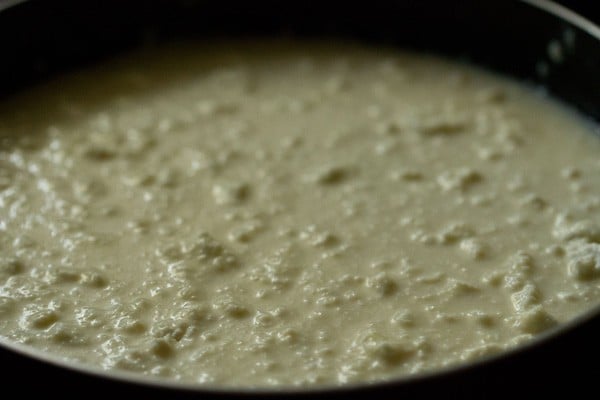
5. I personally added 1 tablespoon of sugar to my batch. Add sugar according to your taste.
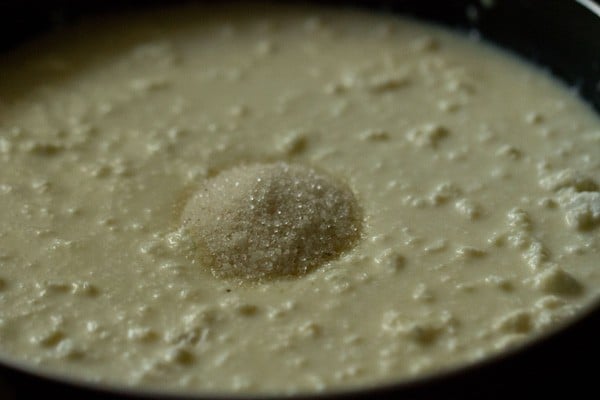
Cook Kalakand Mixture
6. Simmer this mixture over a low heat, stirring at intervals.
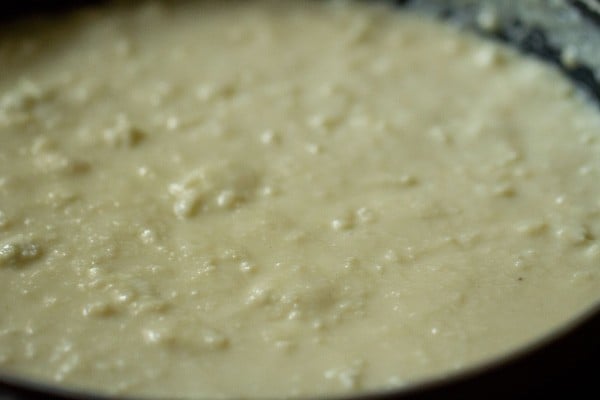
7. Meanwhile, grease a pan or a tray with some ghee or oil. You can also line it with parchment paper.
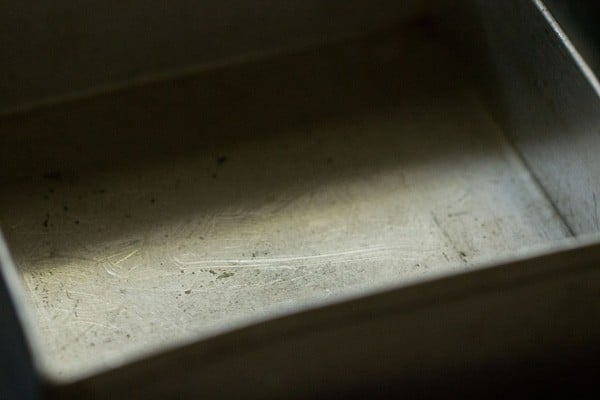
8. Remember to stir the mixture often so that it does not stick to the bottom of the pan.
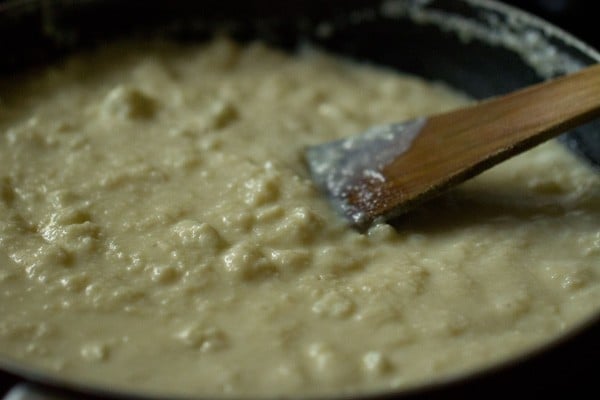
9. The kalakand mixture will start thickening as it simmers and begins to cook.
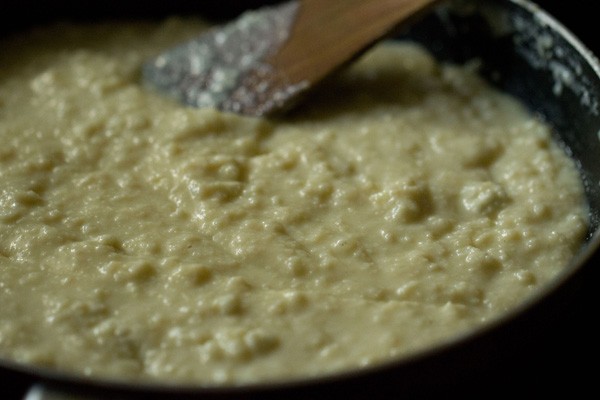
10. When the mixture is well thickened and begins to leaves the sides of the pan, switch off the heat. The mixture should not look dry, there should still be some moisture like in the photo below.
Note: It took me 15 minutes to achieve the right consistency over a low heat. Depending on the quality of your pan, pan thickness and size, and intensity of heat it may take 12 to 16 minutes.
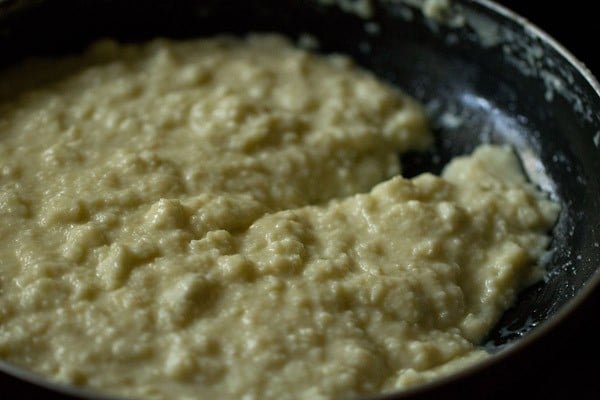
11. Remove the pan from the heat. Add ¾ teaspoon cardamom powder (or flavoring of choice) and 1 teaspoon rose water. Stir very well to evenly incorporate it.
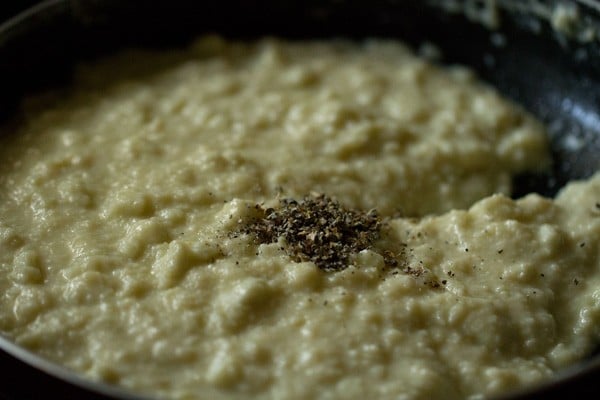
Set Kalakand
12. Now pour the kalakand mixture in the prepared pan or plate.
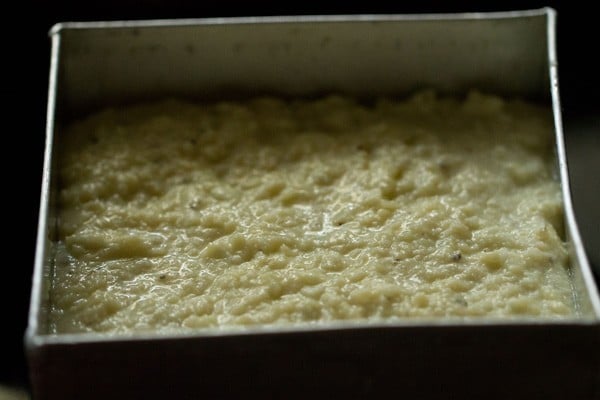
13. Shake the pan so that the mixture spreads evenly. You can also level with a spoon or spatula.
Coarsely crush pistachios, saffron and cashews or almonds in a mortar-pestle. You can also opt slice or sliver the dry fruits, if using.
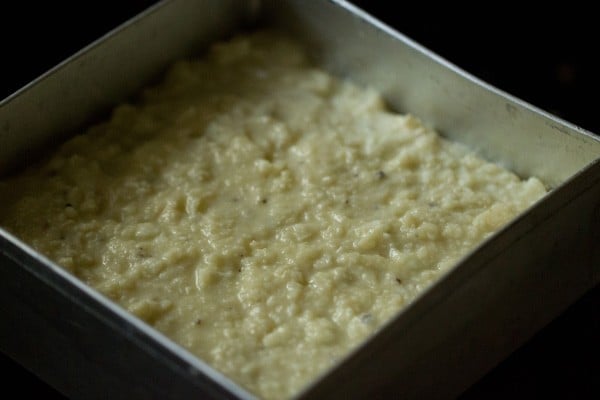
14. Sprinkle coarsely crushed dry fruits and/or thinly sliced or slivered dry fruits all over the kalakand.
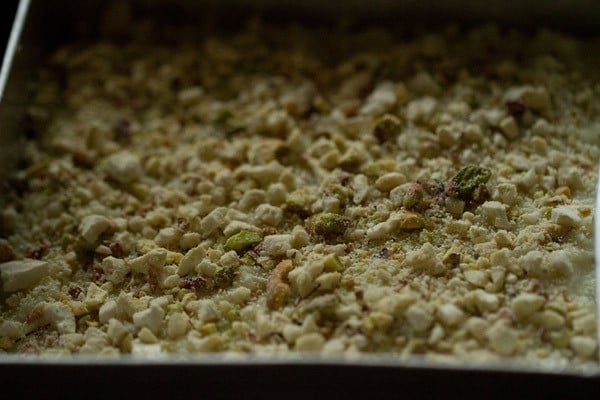
15. Gently press the dry fruits into the milk cake with the back a spoon. Cover and allow the kalakand to cool completely at room temperature.
Cover with foil or lid and place in the fridge for a couple of hours to set.
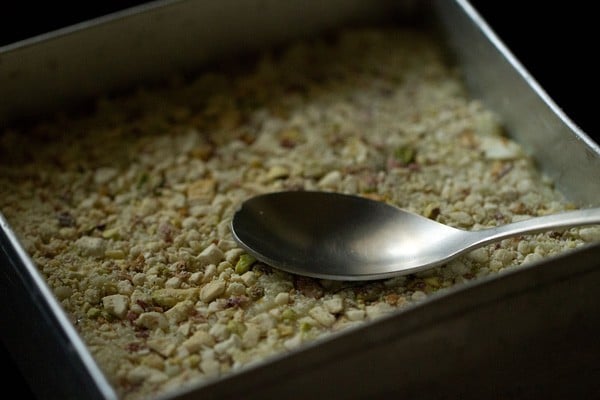
16. This is the kalakand after setting in the fridge.
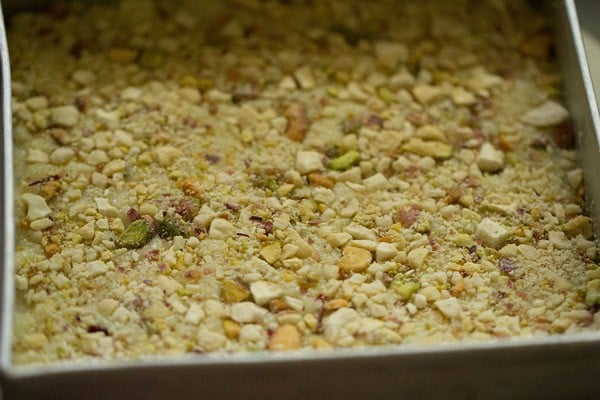
17. Slice kalakand with a knife. In case the kalakand didn’t set up properly, don’t fret. You can just serve it with a spoon like a halwa. It still tastes delicious!
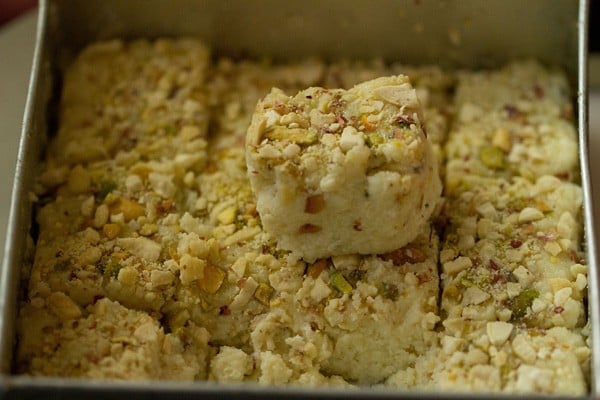
Serve kalakand as a sweet or as a dessert. Keep any leftovers in an air-tight container in the fridge. This sweet keeps well for 2 to 3 days when refrigerated.
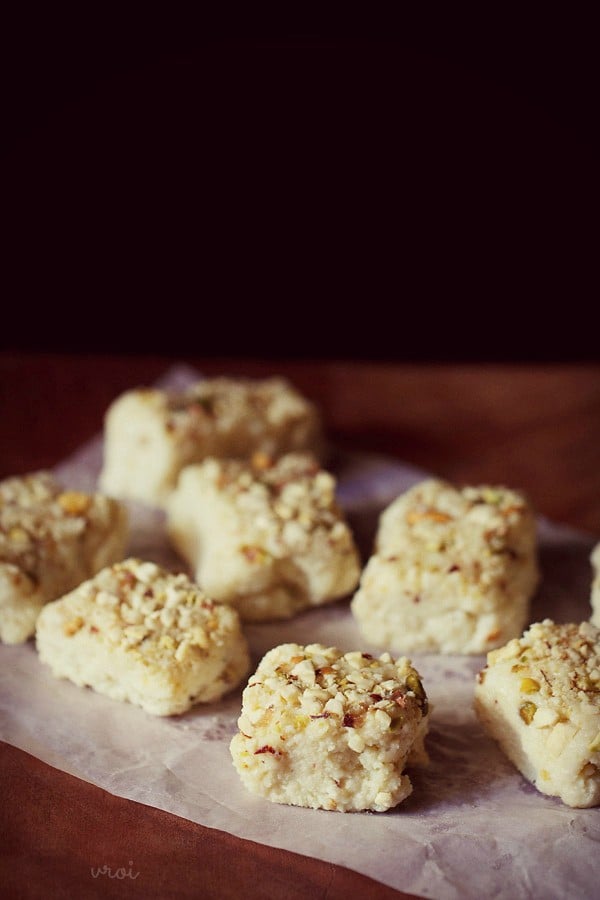
FAQs
Oops! Sounds like you may have cooked it a bit too long on the stovetop. Brush the top of the milk cake with additional milk and it should soften after it settles in.
It sounds like you either used a lower quality paneer, or you overcooked the mixture. For best results, use fresh, homemade Paneer and only cook until the mixture is thick but not dry looking.
You can refrigerate kalakand for up to 2 to 3 days. Try to use fast it is a milk based dish.
Sure! I suggest using ⅓ – ½ cup of thick fruit purée to sweeten the kalakand. Add it before cooking. You can add mango puree or strawberry puree. If adding fruit puree then adjust the sugar as needed.
More Indian Sweets To Try!
Sweets Recipes
Sweets Recipes
Sweets Recipes
Sweets Recipes
Please be sure to rate the recipe in the recipe card or leave a comment below if you have made it. For more vegetarian inspirations, Sign Up for my emails or follow me on Instagram, Youtube, Facebook, Pinterest or Twitter.
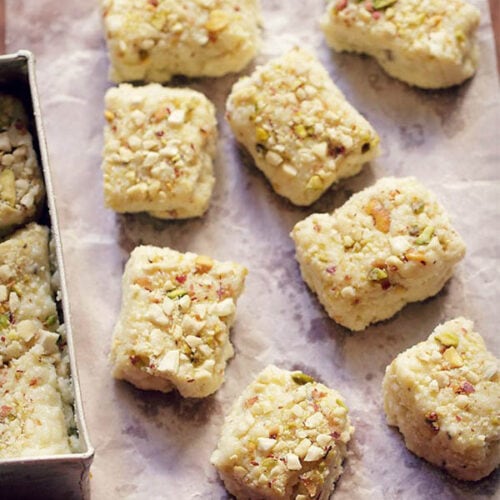
Kalakand Recipe | Kalakand Sweet
Ingredients
- 400 grams sweetened condensed milk or 1 tin or can
- 250 to 300 grams Paneer or 2 cups tightly packed grated or crumbled paneer
- ¾ teaspoon cardamom powder (choti elaichi powder) or 6 to 7 green cardamoms – crushed in a mortar-pestle to a fine powder
- 1 tablespoon sugar (optional)
- 1 teaspoon rose water (optional)
- 10 to 12 pistachios (pista)
- 10 to 12 cashews or almonds (kaju or badam)
- 7 to 8 strands of saffron (kesar) – optional
Instructions
Preparation
- Grease a pan or a tray with some ghee or oil.
- Crush coarsely pistachios, saffron and cashews or almonds in a mortar-pestle. You can also sliver or slice the nuts.
- Grate 250 to 300 grams paneer. You can also crumble the paneer. If the paneer is refrigerated, then I suggest to grate it. If freshly made, then you can crumble it finely. There should be no chunks in the crumble.
Making kalakand sweet
- Take 1 tin/can (400 grams) of sweetened condensed milk in a thick bottomed pan or kadai.
- Add the grated or crumbled paneer to the condensed milk. Mix very well.
- I did add some sugar as I felt the sweet taste was less for us. I added 1 tablespoons sugar. You can check the taste and add accordingly.
- Keep the heat on low or sim and cook this mixture of condensed milk and grated paneer.
- Stir the mixture often so that it does not stick to the bottom of the pan.
- The kalakand mixture will start thickening as it simmers and begins to cook.
- When the mixture gets thickened well, looks like one mass and starts leaving the sides of the pan then switch off the heat.
- Keep in mind that the kalakand mixture should have some moisture and should not look dry. It should not have a liquid consistency or be runny.
- It took me 15 minutes on a low heat. Depending on the quality of your pan, pan thickness and size, flame intensity it may take 12 to 16 minutes.
- Remove the pan from the heat. Add cardamom powder and rose water. Stir very well.
Setting kalakand
- Now pour the kalakand mixture in the prepared greases pan or tray.
- Shake the pan gently so that the mixture spreads evenly. You can also level with a spoon or spatula.
- Sprinkle coarsely crushed nuts or slivered nuts all over the kalakand.
- Gently press the nuts with a spoon. Cover and allow the kalakand to become warm or cool completely at room temperature. Then keep in the fridge for a couple of hours for it to set.
- After it sets, slice the kalakand and serve. In case if you cannot slice the kalakand, then don’t worry. You can just serve it with a spoon like a halwa. It still tastes delicious.
- Serve kalakand as a sweet or as a dessert. Keep any leftovers in the fridge in an air-tight container. Kalakand keeps well for 2 to 3 days in the fridge.
Video
Nutrition Info (Approximate Values)
This Kalakand Recipe post from the archives first published in May 2015 has been updated and republished on 22 October 2022.
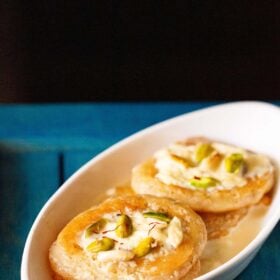
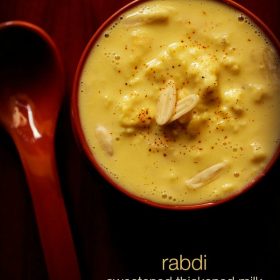
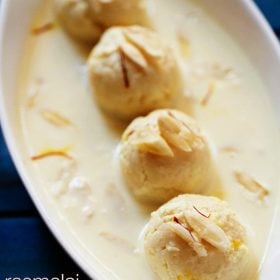
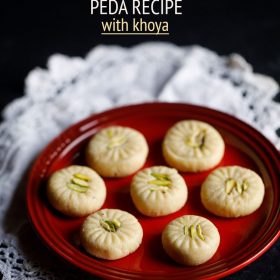
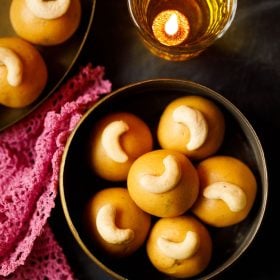
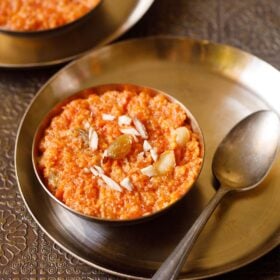
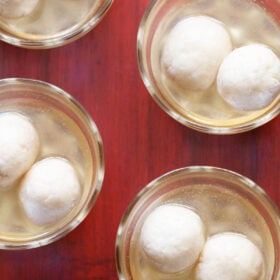
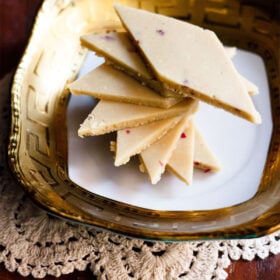








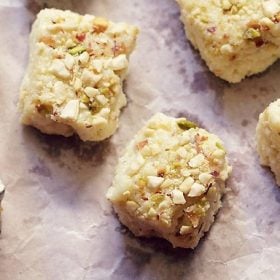
Very Nice.